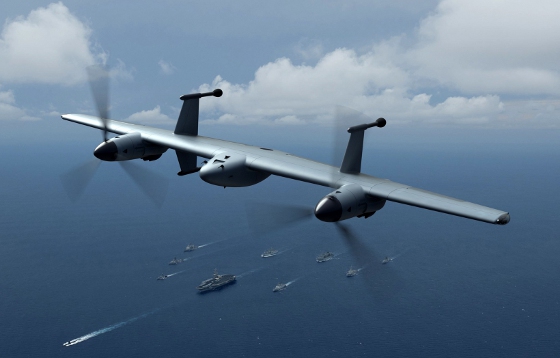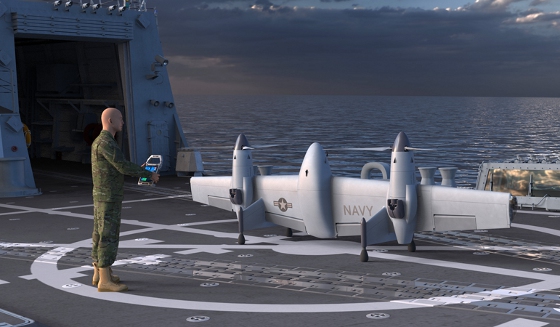 |
| June 04, 2024 | Volume 20 Issue 21 |
Designfax weekly eMagazine
Archives
Partners
Manufacturing Center
Product Spotlight
Modern Applications News
Metalworking Ideas For
Today's Job Shops
Tooling and Production
Strategies for large
metalworking plants
Sikorsky testing 'rotor blown wing' tail-sitter unmanned aircraft concept for DARPA project

Sikorsky is flight testing a rotor blown wing tail-sitter VTOL UAS. Proprotors, electrification, and autonomy are key enabling technologies for efficient vertical and horizontal flight. [Credit: © 2024 Lockheed Martin Corporation. All rights reserved]
Sikorsky Aircraft is conducting flight tests to mature the control laws and aerodynamics of a novel vertical takeoff and landing (VTOL) uncrewed aerial system (UAS). The flight tests are intended to prove the efficiency and scalability of a twin proprotor "rotor blown wing" configuration that sits on its tail to take off and land like a helicopter and transitions easily to horizontal forward flight for long-endurance missions, such as intelligence, surveillance, reconnaissance, and targeting.
The term "rotor blown wing" refers to the constant airflow from the proprotor wash across the wing. Sikorsky chose the design to reduce drag on the wing in hover mode and when transitioning to forward flight, and to increase cruise efficiencies and endurance.
The ongoing flight tests support the AdvaNced airCraft Infrastructure-Less Launch And RecoverY (ANCILLARY) initiative by the Defense Advanced Research Projects Agency (DARPA), which seeks to develop a Class 3 UAS VTOL X-Plane that can operate in most weather conditions from ship decks and unprepared surfaces without infrastructure. Sikorsky is one of several competitors down-selected to advance their UAS conceptual designs into the next development phase.

Graphical rendering of a Sikorsky rotor blown wing VTOL UAS ready for launch from a ship's deck. The tail-sitting aircraft flies autonomously via Sikorsky's MATRIX™ autonomy system. [Credit: © 2024 Lockheed Martin Corporation. All rights reserved]
"Flight tests are underway to verify our tail-sitting, rotor blown wing UAS can launch and land vertically with high stability and cruise efficiently on wing," said Igor Cherepinsky, director of Rapid Prototyping Group, Sikorsky Innovations. "Key enablers to flight maneuverability, and future vehicle scalability, are our MATRIX autonomy flight control system and an articulated rotor system similar to those in traditional helicopters," he said.
Sikorsky has not publicly disclosed the size of the subscale, experimental, rotor blown wing aircraft prototype. However, a July 2023 Aviation Week article stated that the company requested a special exemption from the FAA in June 2023 "to Part 91.151 regulations requiring fuel reserves for at least 30 min. of fixed-wing flight or 20 min. of rotary-wing flight while operating under day visual flight rules." The request was for a tail-sitter with a "single turbine engine powering two wing-mounted semi-articulated proprotors generating slipstream that flowed over the wing to increase lift. The aircraft could hover on its proprotors like a rotary-wing aircraft or cruise like a conventional fixed-wing aircraft."
According to the article, "The aircraft Sikorsky plans to fly has a maximum takeoff weight of 115 lb. and can reach a maximum speed of 125 kt, the application says."
Matrix Technology is an architecture of software and hardware components, or "apps," that enable autonomous execution of complex missions in close proximity to obstacles at a new level of system reliability.
Designed to be platform independent, MATRIX technologies can be readily applied to benefit Sikorsky unpiloted or piloted vehicles as well as vehicles not originally designed by Sikorsky.
Matrix Technology addresses four fundamental challenges:
- Low-altitude, obstacle-rich autonomous flight;
- Multi-level contingency management to achieve a needed 100X improvement in levels of system reliability;
- A path to qualification or certification; and
- Lifecycle cost reduction.
Matrix was introduced in 2013 to develop, test, and field hardware and software systems that aim to significantly improve optionally piloted and piloted VTOL aircraft. Sikorsky has even installed MATRIX on a BLACK HAWK helicopter.
The Matrix Technology program is led by Sikorsky Innovations, the same rapid prototyping organization that in 2010 proved the physics of efficient 250-knot flight in a rotorcraft with its X2 Technology Demonstrator program.
For the flight tests now underway for the rotor blown wing aircraft, Sikorsky is flying a proof-of-concept vehicle powered by a battery. If selected to produce an air vehicle for a future ANCILLARY phase, Sikorsky plans to build a 300-lb hybrid-electric version to include a 60-lb intelligence, surveillance, and reconnaissance (ISR) payload.
"A network of these small UAS can be launched from a ship to provide beyond-line-of-sight F2T2 (find, fix, track, target) of surface vessels of interest for the ship commander," said Steve Komadina, DARPA program manager for ANCILLARY. "While we anticipate this effort is most likely to support Navy and Marine missions, we have found other services are very interested in the capabilities this technology can bring to diverse missions, including logistics, strike, and special uses by the Army, Air Force, Special Operations Command, and Coast Guard."
Sikorsky is a Lockheed Martin company.
Sources: Sikorsky, Lockheed Martin, Designfax, Aviation Week
Published June 2024
Rate this article
View our terms of use and privacy policy
